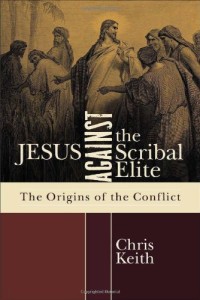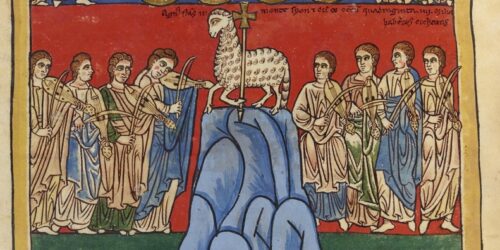Chris Keith’s thought-provoking and worthwhile new book
Chris Keith
Jesus against the Scribal Elite: The Origins of the Conflict
Grand Rapids: Baker Academic, 2014; ISBN 978-0-8010-3988-1
[As many readers of this review will recognise, the author of this book is my colleague at St Mary’s University, Twickenham. Professor Chris Keith was kind enough to give a copy of the book I review here, but without any request for review, let alone—of course—for a favourable review. What follows is my responsibility alone.]
Get a cup of coffee (or your preferred tipple)—this is a longish review article, but well worth reading!
This is a remarkable book in many respects. It has the rare scholarly quality of succinctness (the entire argument is stated, made, and objections met, in just over 150 pages), combined with great clarity and focus of argument, and it highlights an important factor in the life and ministry of Jesus which is greatly neglected (or rejected) in scholarly discussion. If Professor Chris Keith is substantially right (and I am persuaded that he is), there is an important factor to add into our reconstructions of why Jesus was opposed by the educated Jewish elite, and that is that he acted and spoke in ways which challenged their exclusive hold on the right to teach and, especially, to intepret Scripture.
It is not simply that Jesus taught differently to the ‘scribal elite’ (as Keith dubs them); it is that, in their view, he had no right to teach, and their opposition to him stemmed initially from that belief. Moreover, that Jesus then had the audacity to best them in debate about Scripture rubbed salt into their wounds—in a society where honour and shame were key values, and where honour and shame were a zero-sum game (so that there were limited amounts of honour to be had), Jesus’ growing honour could only mean the scribal elite’s shame. Matthew 23 portrays such controversy at its most extreme, as Jesus criticises the Pharisees in language which can only be described as vehement.
How does Keith make his argument? There are six key steps.
First, he observes that scholars regularly recognise that Jesus came into conflict with the scribes, Pharisees and Sadducees. However, such scholars see Jesus and his opponents as in dispute simply over the content of Jesus’ teaching, notably on the status of the Torah. Many add that Jesus’ miracles and exorcisms would give him great prestige and would antagonise his opponents further. Keith goes beyond both of these observations to argue that the very fact that Jesus taught, and particularly taught from Scripture, was itself in dispute. The record of Jesus teaching in the synagogue at Nazareth (Mark 6:1-6 and parallels) is unique in extant literature in presenting a person who is not a member of the scribally-trained minority engaging in such synagogue teaching. For a carpenter (Mark 6:3) to do this is without precedent, and would lead to questions: some would identify Jesus as a teacher of the same kind as the scribal elite, and others would question how an artisan might do such a thing.
Secondly, Keith presents a valuable and clear summary of the kind of teachers there were in first-century Palestine (ch. 1), in order to sharpen the question of what kind of teacher Jesus might have been identified to be. He identifies six key points: (i) following classicist William Harris and others, the vast majority of the first-century population were illiterate. He here points to the lack of solid evidence for widespread ‘synagogue schools’, which many claim taught reading and writing (according to Keith, erroneously)—if scholars wish to challenge Keith, they will need to provide such evidence. (ii) Even among those who were literate, there were degrees of literacy, varying from (for example) highly educated Torah teachers (highly literate) to village scribes (moderately literate) to vineyard tenants (needing only very basic literacy). (iii) The skills of reading and writing were separately acquired: a person could be able to read without being able to write and copy a text they could read. Such Jewish people could be greatly devoted to Scripture, but unable to copy or write it. (iv) The multilingual environment of first-century Palestine requires us to ask which language it was in which a person was literate: Hebrew, Aramaic, Latin and Greek were all in use in this time and place. (v) Within the broad category of ‘literacy’ exist the more specialist skills of ‘scribal literacy’, that is, the ability to read and interpret the Hebrew Scriptures. Some (such as the scribes) could both read and write their sacred texts; others (perhaps some of the ‘teachers of Torah’) might only be able to read, but were sufficiently educated to act as teachers of Scripture whose teaching authority was recognised. Either group might act as ‘text brokers’ for the illiterate majority. The key issue in relation to Jesus is whether he was perceived as a member of this scribal elite who possessed such advanced literacy. (vi) The social perception of a person’s scribal literacy (or not) is the crucial thing to recognise. A person might be perceived as scribally literate (Keith consistently calls this ‘scribal literate’, which feels like an Americanism to this Brit) without that person having been seen actually reading Scripture or offering exposition of Scripture in public—thus, simply being known as a Pharisee would probably lead others to assume such scribal literacy.
In the light of these six points, Keith highlights the significance of the synagogue as the venue where scribal literacy skills would be demonstrated. Given the illiteracy of the majority, they would be reliant on the small scribally literate elite to read and interpret Scripture for them in the synagogue sabbath by sabbath. Indeed, to read and interpret Scripture required not only the ability to read a Hebrew text, but also the ability to find the place to be read in a scroll. The latter required the ability to recognise (in effect) the whole of the text in times before codices and chapter and verse divisions. Luke 4:17 and John 5:39; 7:52 refer to this ability as a feature of the scribally literate elite.
Thirdly, Keith studies the portraits of Jesus as teacher in the Gospels (ch. 2), and argues that there is a tension in these portraits. Mark and Matthew portray Jesus as lacking the qualities required in a member of the scribal elite, whereas Luke portrays Jesus as being understood to be a member of that group. John makes it clear that there is controversy precisely over whether Jesus was a member of the scribal elite or not (e.g. John 7:15). Keith wisely observes that we need to take care over whose voice we are hearing in comments about Jesus, not least concerning his scribal literacy—so John 7:15 is the opinion of Jewish people about Jesus, not John’s authorial voice or the voice of a reliable character. John records only that the audience asked this question, not whether they were right or not.
In Mark 6:3 Jesus is identified by the people of Nazareth as a carpenter, a class who were routinely not literate to any significant degree. And yet, Mark portrays Jesus as a powerful and effective teacher (e.g. 1:22, 39). Interestingly, Matthew 13:55 has the Nazareth synagogue audience ask, ‘Is this not the carpenter’s son?’, suggesting that Matthew recognises there is a problem in Jesus’ identification as a carpenter in Mark’s account, and therefore words the question slightly differently to reflect this recognition. In common with Mark, Matthew portrays Jesus as a powerful and authoritative teacher who cricitises the scribally literate elite.
Luke, by contrast, has the crowd ask, ‘Is this not Joseph’s son?’ (4:22), removing any mention of Jesus’ trade. This difference is underlined by Jesus standing ‘in order to read’, unrolling the Isaiah scroll, finding the passage which he reads, and then rolling up the scroll (4:16-20). Moreover, by contrast with Mark and Matthew (where Jesus does not enter a synagogue again after Nazareth, and teaches in the open, e.g. Mark 10:1), Luke has Jesus regularly teaching in synagogues (6:6; 13:10)—he is a recognised synagogue teacher. Other factors point to Luke underlining that Jesus has such scribal literacy, not least his teaching the two on the Emmaus road after the resurrection (24:27, 32; cf. vv 44-45).
Given the tensions within the Gospel tradition, the question naturally arises: who is right? Did Jesus have scribal literacy or not? Was one portrait or other a reflection of the perception of the crowds, rather than reflecting the actuality of Jesus’ upbringing?
An interlude in the main argument considers scholarly understanding of the historical Jesus when the tradition contains such tensions (ch. 3). Here, Keith notes the scholarly tendency to regard one feature as inauthentic and the other as authentic, rather than to ask the question why the two features might both be present in the tradition within the first century. This is a most interesting and helpful way to address such tensions and opens up new possibilities. En route, Keith provides a valuable brief summary of grounds for rejecting a criteria-based approach to historical Jesus studies (on which he has written, with others, at greater length in Jesus, Criteria, and the Demise of Authenticity). He recognises that texts about previous times (such as the Gospels) are necessarily coloured by the author’s later perspective, but cogently argues that this does not mean there is nothing of historical value in these texts. Rather, the past is being re-presented, and a memory-based approach (which Keith advocates) seeks to explain what is in the text, rather than explain it away.
The main argument resumes, fourthly, by Keith proposing that the explanation for this tension among the Gospel traditions is that Jesus himself lacked scribal training, but that he was perceived as having such training because of the way he understood and interpreted Scripture in his teaching and/or his engagement with those known to be scribally literate teachers (ch. 4). Keith here takes up the cudgels against Crossan and Kelber, who both argue that, since Jesus was illiterate, therefore (for Kelber) different Evangelists successively changed the portrait of Jesus to that of a scribally literate person, or (for Crosssan) the later Christian focus on texts led to the image of Jesus changing to a scribally literate person. Keith agrees with them that Jesus himself was scribally illiterate, a portrait that persists into the time of the Infancy Gospel of Thomas (late 2nd century) and Origen’s debates with Celsus (third century). Later Christians would have reason to portray Jesus as highly educated, so the persistence of the ‘illiterate’ strand is significant evidence.
Jesus’ teaching activities invited assessment in a society where scribal literacy was rare, and the Gospels reflect such debate, putting questions about Jesus’ status as a teacher on the lips of friends and opponents. Thus it is highly likely that the mixed perceptions of Jesus’ scribal literacy arose within his own lifetime.
Fifthly, Keith delineates the arguments over Jesus’ teaching, and proposes that two key matters of dispute in the Gospel controversy stories are the interpretation of Scripture, and Jesus’ own authority to teach (ch. 5). Keith illustrates the controversies over Scripture interpretation from the Torah, the Prophets, and the Writings. He goes on to show that Jesus’ own authority to teach (not only the content of his Scripture interpretation) is at stake in these controversies: the question is, ‘Who do you think you are?’ and not only, ‘What does this text say?’ Jesus himself, according to the Gospels (or, at least, some Gospel passages), participates in the authority of God to teach and speak in this way (I can hear Bauckham, Hurtado and numerous others saying, ‘Amen’ at this point). Keith is clear that he is not suggesting that the nature of these controversies is the only factor in the opposition to Jesus, but he is suggesting that they are a highly significant factor, and this argument is strong and well made.
Finally, Keith then offers his own reconstruction of the situation during the ministry of Jesus, making a cogent case for the historicity of the controversy traditions (ch. 6). This enables him to engage with and critique previous scholarship, whether in the failure to recognise the significance of these controversies, or simply in scholars arguing that the controversies are the projection of later Christian controversies with their opponents back into the life of Jesus. He debunks the latter argument he powerfully debunks by pointing to the irrelevance of much of the debate in the Gospels to the issues we know were present in early Christianity (a critique offered, among others, by the late Dick France as far back as 1977). Keith’s case (he says) is not necessarily for the historicity of every detail of every controversy story; rather he seeks to argue for the historicity of controversy between Jesus and the scribal elite, and controversy which included both scriptural interpretation and Jesus’ authority to teach as key foci. Keith thus provides a masterly critique of E. P. Sanders’ argument (in Jesus and Judaism) that the controversies over Scripture cannot be seen with any confidence as rooted in Jesus’ ministry. Keith closes this chapter by sketching the scenario with which I began this review, his own, positive portrait of the origins and development of the controversy over Jesus’ status as a teacher.
I have summarised this argument at length because I consider it highly significant. As a result of this book, we need to add the controversy over Jesus’ own status as a teacher, given his probable scribal illiteracy, as a vital factor to our understanding of Jesus’ life and ministry. Keith’s argument, again, is not that it is the only factor in Jesus’ later arrest, trial and death, but that it has explanatory power as to how Jesus initially entered into debate with the scribal elite—debate which was a significant factor in the growing opposition to Jesus. Other factors, long recognised, such as Jesus’ healings, exorcisms, critique of the temple’s corruption, claims to be the son of man, and implicit messianic claims, are clearly vital too.
One fascinating question which this book highlights is: where did Jesus get his ability to teach from, so that some understood him to have scribal literacy? How was he able to debate with the teachers in the temple as a child? Where did his ability to understand and teach Scripture in the way he did come from? Advocates of an early high Christology will recognise that these features, in combination with Keith’s argument, might well point to the kind of divine enabling which Luke hints at when he states that Jesus grew in favour with God (Luke 2:52). And how did the trajectory of Christian understanding of Jesus’ scribal literacy develop? There is at least one PhD to be written in this area, for sure!
It is refreshing to read this book, which challenges our thinking, opens our eyes to new features and factors in the story of Jesus, and provides cogent argumentation for the historicity of large tracts of the Gospels en route. Read it: you’ll benefit from it!




Thank you for the review. I just finished preaching from John 10 on Sunday and became fascinated with Jesus’ use of the double Amen introducing his teachings. Are there any examples in Second Temple Judaism of rabbis beginning their teaching with a single or double Amen? My understanding is that the rabbi’s disciples would insert this at the end, authenticating the truth of what’s been said. Jesus placing the double Amen to being his sayings would seem to indicate that he doesn’t need anyone authentication, for his is the Amen, the faithful and true witness (Rev. 3:14). Any thoughts on this?
(sorry i corrected the first typos in my first comment)
Thank you for the review. I just finished preaching from John 10 on Sunday and became fascinated with Jesus’ use of the double Amen introducing his teachings. Are there any examples in Second Temple Judaism of rabbis beginning their teaching with a single or double Amen? My understanding is that the rabbi’s disciples would insert this at the end, authenticating the truth of what’s been said. Jesus introducing his sayings with the double Amen would seem to indicate that he doesn’t need anyone’s authentication, for he is the Amen, the faithful and true witness (Rev. 3:14). Any thoughts on this?